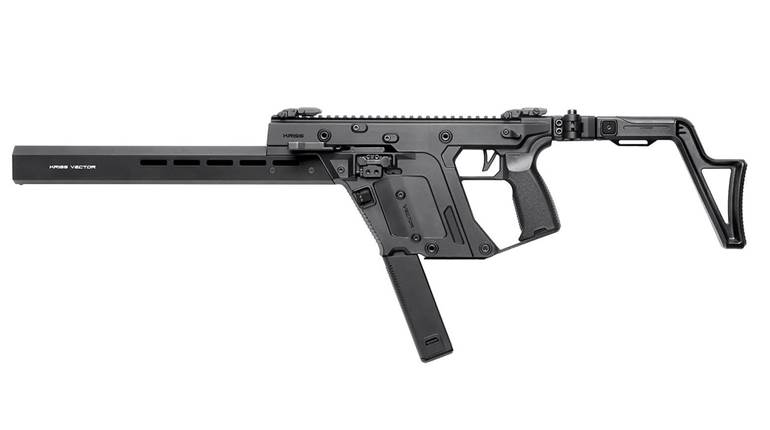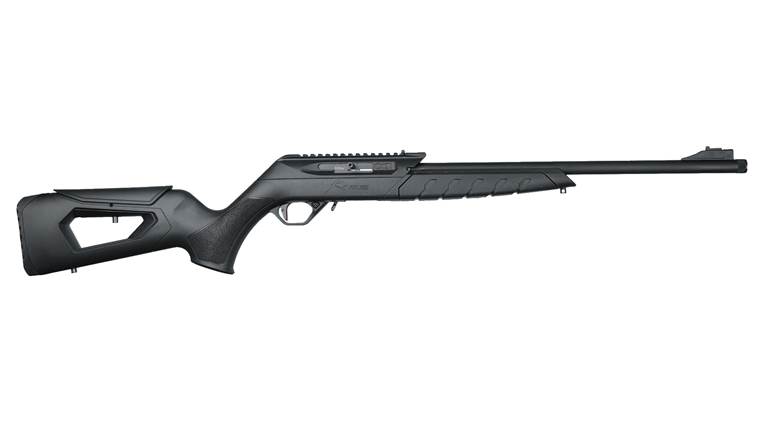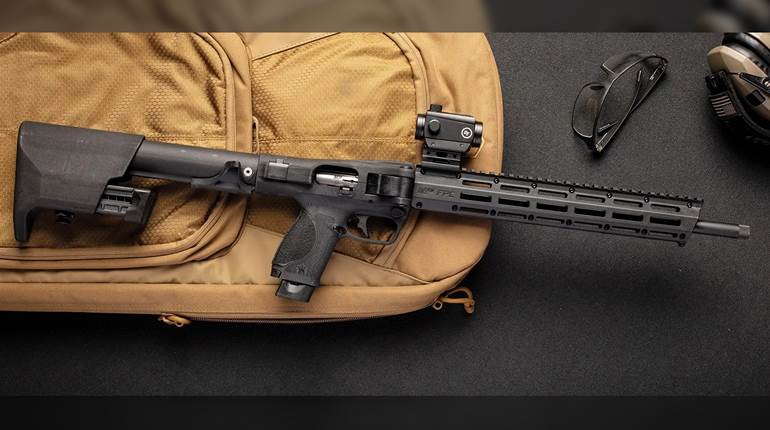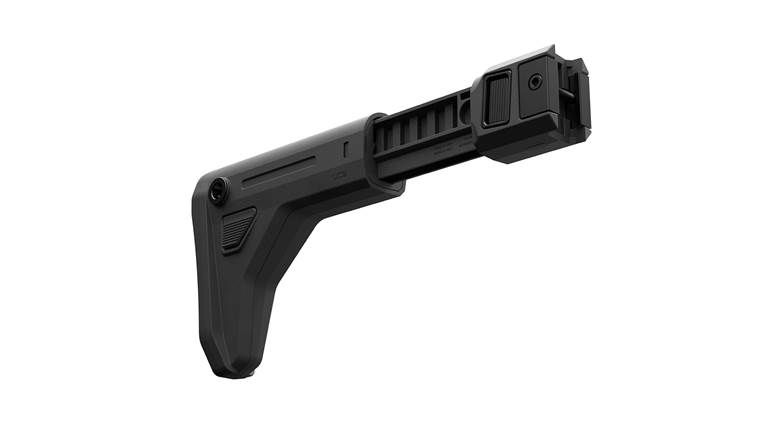
Pistol-caliber submachine guns and carbines have become de-emphasized somewhat in military and law enforcement circles for want of firearms chambered in more powerful rifle cartridges, such as the 5.56x45 mm NATO. While this trend toward intermediate rifle rounds has undoubtedly been a good move for the military, more power is not always needed or desired in every civilian application. The Just Right Carbine is a U.S.-made, pistol-caliber carbine that effectively bridges the broad power gap between long guns chambered for rimfire cartridges and those using bottleneck rifle rounds. This modular firearm is chambered in 9 mm Luger, .40 S&W and .45 ACP, and each carbine is interchangeable between all three calibers.
At first glance, the JR Carbine is just another AR variant. Though it shares numerous parts and an outward appearance with the ubiquitous AR platform, the JR is actually of a totally different design. Unlike the AR’s gas-operated action, the JR Carbine uses a simple blowback system similar to that of the Ruger 10/22. The bolt is held forward by spring pressure and is cycled by the energy of the fired round; there are no gas tubes or pistons involved. While it doesn’t use the AR’s operating system, the JR Carbine does share with the AR its modularity and some parts commonality, so many of the myriad of AR accessories can be used on the JR. The carbine uses a standard commercial diameter AR buffer tube so any buttstock compatible with a commercial AR can be fitted to the JR. The buffer itself is not interchangeable with standard AR buffers as the JR uses an extra heavy buffer to counter the inertia of the blowback design. Mil-spec and commercial AR parts are also interchangeable with the carbine’s AR-style trigger, grip, and safety, as well as any accessories that mount to the Picatinny rail such as auxiliary iron sights, scope mounts or lights. This carbine comes ready to accessorize.
Operation of the JR Carbine is straightforward and similar to most traditional semi-automatic firearms. It uses standard cartridge-appropriate Glock pistol magazines (and, in certain models, M1911 magazines) that are inserted into the magazine well forward of the triggerguard. The carbine relies on the magazine catch to hold the magazine at the proper position so it is important not to slam the magazine into the firearm as that can lead to the magazine overriding the catch and causing malfunctions. The side-mounted charging handle is pulled to the rear and released to chamber a round.
The JR uses an AR-style manual safety on its left side, which is disengaged by moving the lever clockwise to the 12 o’clock “FIRE” position. The 6-pound, 8-ounce single-stage trigger is a standard AR model and works like any other semi-automatic. A bolt-mounted extractor and receiver-mounted ejector expend empty cases horizontally through the reversible ejection port just aft of the chamber. The bolt does not automatically lock to the rear on an empty magazine; however, the charging handle can be locked downward into a bolt catch cutout in the charging handle slot.
Disassembly of the JR Carbine for cleaning is a bit more involved than most long guns on the market, and requires a few specific tools to accomplish. Starting with an unloaded firearm with the bolt in the forward position, the buffer tube nut must be loosened using an AR-style stock wrench. The receiver plate is then slid away from the receiver to allow the buffer tube/stock assembly to rotate and the tube assembly is turned counter-clockwise until it can be removed from the receiver. The bolt is then moved to the rear and an Allen-screw inside the bolt handle is removed. With the bolt handle out, the bolt can be removed from the rear of the receiver, which allows access to the breech. If barrel removal is desired, the quad-rail/handguard must be removed using the appropriate spanner wrench before the barrel can be unscrewed using an AR-barrel wrench. It is not necessary to remove the barrel in order to clean it from the breech end as it can be cleaned through the rear of the receiver. At this stage in the disassembly process, changing calibers can be accomplished by changing the barrel, bolt, magazine well, and magazine. Helpful “how to” videos are available on the company’s website.
Unlike most semi-automatic rifles or carbines, the JR is almost fully ambidextrous. The charging handle, ejection port, and magazine release are reversible for right or left-hand operation. Like the basic disassembly steps, this process requires the use of tools and is somewhat involved, but it shouldn’t require professional help for anyone who is reasonably handy and can follow instructions.
Shooting the JR Carbine was enjoyable. It was accurate and both recoil and muzzle blast 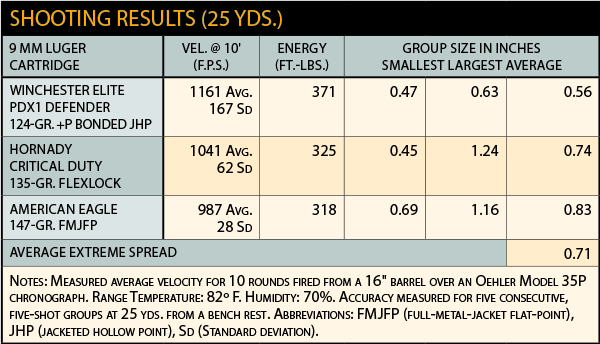 were virtually non-existent despite using full-power and +P ammunition. Our 9 mm test carbine functioned with 100 percent reliability using a 17-round Glock magazine and three different brands of ammunition, including hollow-points. Accuracy from the bench was excellent and rapid hits on offhand targets were made easy with the use of a low-power optic. The dipped pink, purple, and white “Muddy Girl” camo pattern featured on our test model gave the carbine a unique look. The barrel is threaded for flash suppressors available from the manufacturer; unfortunately the threads do not match the most common threads for sound suppressors, which would make a great accessory for this carbine.
were virtually non-existent despite using full-power and +P ammunition. Our 9 mm test carbine functioned with 100 percent reliability using a 17-round Glock magazine and three different brands of ammunition, including hollow-points. Accuracy from the bench was excellent and rapid hits on offhand targets were made easy with the use of a low-power optic. The dipped pink, purple, and white “Muddy Girl” camo pattern featured on our test model gave the carbine a unique look. The barrel is threaded for flash suppressors available from the manufacturer; unfortunately the threads do not match the most common threads for sound suppressors, which would make a great accessory for this carbine.
Given the JR Carbine’s light weight, adjustable length-of-pull, and minimal recoil, it would be a great intermediate gun for inexperienced shooters looking to graduate from the rimfire power level. The JR Carbine is also a perfectly legitimate home-defense firearm, especially if equipped with a quality red-dot optic and a light. The JR Carbine is a unique, functional, and compact firearm that is fun to shoot. It fills an un-crowded niche in an otherwise crowded carbine market.
Manufacturer: Just Right Carbines, P.O. Box 430, Canandaigua, NY 14424; (585) 396-1551
Caliber: 9 mm Luger (tested), .40 S&W, .45 ACP
Action type: blowback-operated, semi-automatic carbine
Receiver: anodized aluminum
Finish: anodizing/black oxide; hydro-dipped “Muddy Girl” camo (tested)
Barrel: 16" 4140 Steel
Rifling: six-groove, 1:16" RH twist
Sights: none; Picatinny rail for scope mountingTrigger pull: single-stage 6-lb., 8-oz. pull
Handguard: aluminum quad-rail
Stock: AR-type collapsible polymer: length of pull, 10½" to 141⁄4"; drop at heel, 1/2"; drop at comb, 1/2"
Magazine: Glock detachable-box, 17-round capacity (tested)
Overall Length: buttstock extended, 331⁄2"; collapsed, 301⁄4"
Weight: 6 lbs., 13 ozs.
Suggested Retail Price: $774












